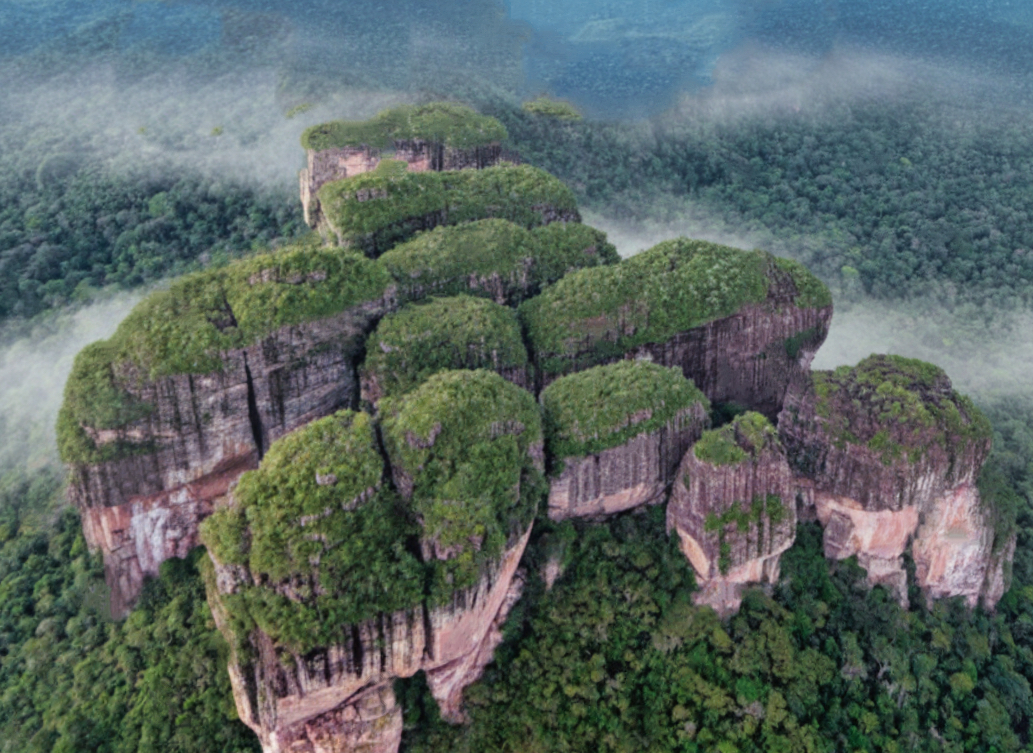
Chiribiquete,
Arte Rupestre del Amazonas
Chiribiquete, conocido como la «Maloca del Jaguar» (Casa de los Jaguares), es una remota región en la Amazonía colombiana. Su corazón es la Serranía de Chiribiquete, una imponente meseta que se eleva desde la vasta selva tropical, dominando el paisaje con su majestuosa silueta.
Impacta por su belleza natural virgen y una flora y fauna excepcionales. Es mundialmente famosa, sobre todo, por sus tepuyes (mesetas), que conservan un tesoro arqueológico de singular importancia: sus pinturas rupestres prehistóricas.
Sin embargo, estos pictogramas son mucho más que arte; son crónicas vivas. Documentan la trayectoria y la evolución de los antepasados de una fascinante civilización que ha habitado la selva amazónica durante milenios y que sigue siendo su hogar hasta el día de hoy.
Nos transmiten, con una impresionante fuerza de tradición, la historia y el legado de estas personas, desde la última Edad de Hielo, a lo largo de milenios, hasta el presente.
Creados en las rocas de Chiribiquete, narran desde la antigua caza de animales de la Edad de Hielo, extintos desde hace miles de años, hasta las distintas épocas: los fatídicos encuentros con los españoles y sus consecuencias devastadoras, los conflictos posteriores durante el auge del caucho, y su subsiguiente retirada al aislamiento.
Una Ventana al Pasado de la Humanidad
Las pinturas rupestres son una ventana al pasado de la historia humana y una prueba de las experiencias diversas y profundas de nuestros antepasados en este continente.
Son testimonios vivos de la creatividad, la resiliencia y la profundidad cultural de las civilizaciones en la selva amazónica, así como una fuente inagotable de conocimientos e ideas históricas que nos muestran cuánto queda por aprender sobre nuestro pasado.
De esta manera, Chiribiquete no solo nos transporta a un pasado distante, sino que también nos conecta con un presente lleno de misterios y maravillas.
Es un espacio donde la historia y la cultura se fusionan con la naturaleza de una manera especial, animándonos a desvelar los secretos ocultos del Amazonas y de sus enigmáticos habitantes.
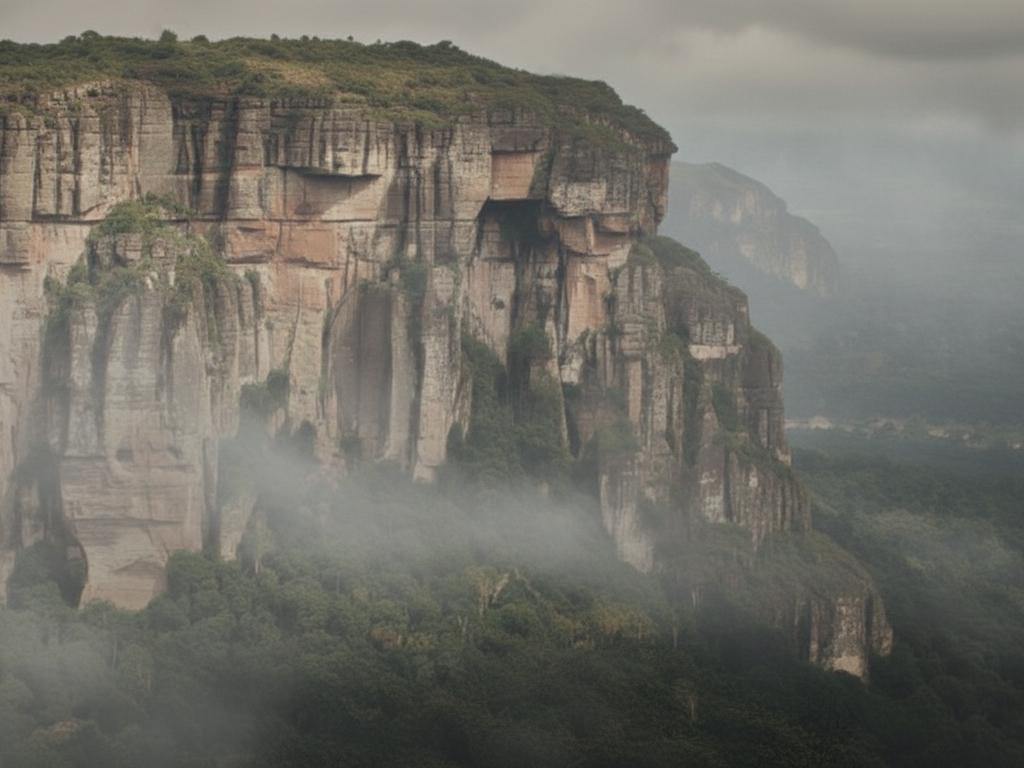
El Descubrimiento: Pinturas Rupestres, Historia y Misterios
La historia de Chiribiquete es verdaderamente fascinante. Todo comenzó cuando Carlos Castaño-Uribe, volando en su avioneta Cessna sobre la selva amazónica en los años 80, se desvió de su ruta debido a una tormenta repentina. A través de las nubes, se le apareció una vista impresionante: un tepuy que se erguía majestuosamente desde la selva.
Intrigado, sobrevoló la zona y descubrió toda una cadena montañosa que no estaba registrada en ningún mapa. Decidió explorar más a fondo este lugar misterioso.
Un año después, Castaño-Uribe regresó en helicóptero y descubrió los enigmáticos pictogramas en esta sierra, que se extendían a lo largo de una pared de roca de arenisca de más de 14 kilómetros. Decidió dedicar su vida a la exploración de Chiribiquete a partir de entonces.
Sus esfuerzos fueron cruciales para la fundación del Parque Nacional Natural Serranía de Chiribiquete en 1989. Con una superficie de $42.681 km2, es el parque nacional tropical más grande del mundo. Fue reconocido como Patrimonio Mundial por la UNESCO en 2018.
Las pinturas rupestres encontradas en el parque sirven como un libro de historia de milenios de antigüedad que es continuamente actualizado por los habitantes indígenas de la región. Estas pinturas ancestrales, algunas de las cuales datan de hasta $20.000$ años según la datación por radiocarbono, demuestran la persistente creatividad y habilidad artística de las comunidades nativas.
El arte rupestre del parque, que abarca desde los tiempos más antiguos hasta la década de 1970 e incluso más allá, es una crónica única. Combina expresión artística, testimonio histórico y secretos inexplorados que, hasta hace poco, permanecían ocultos en las profundidades de la selva amazónica.
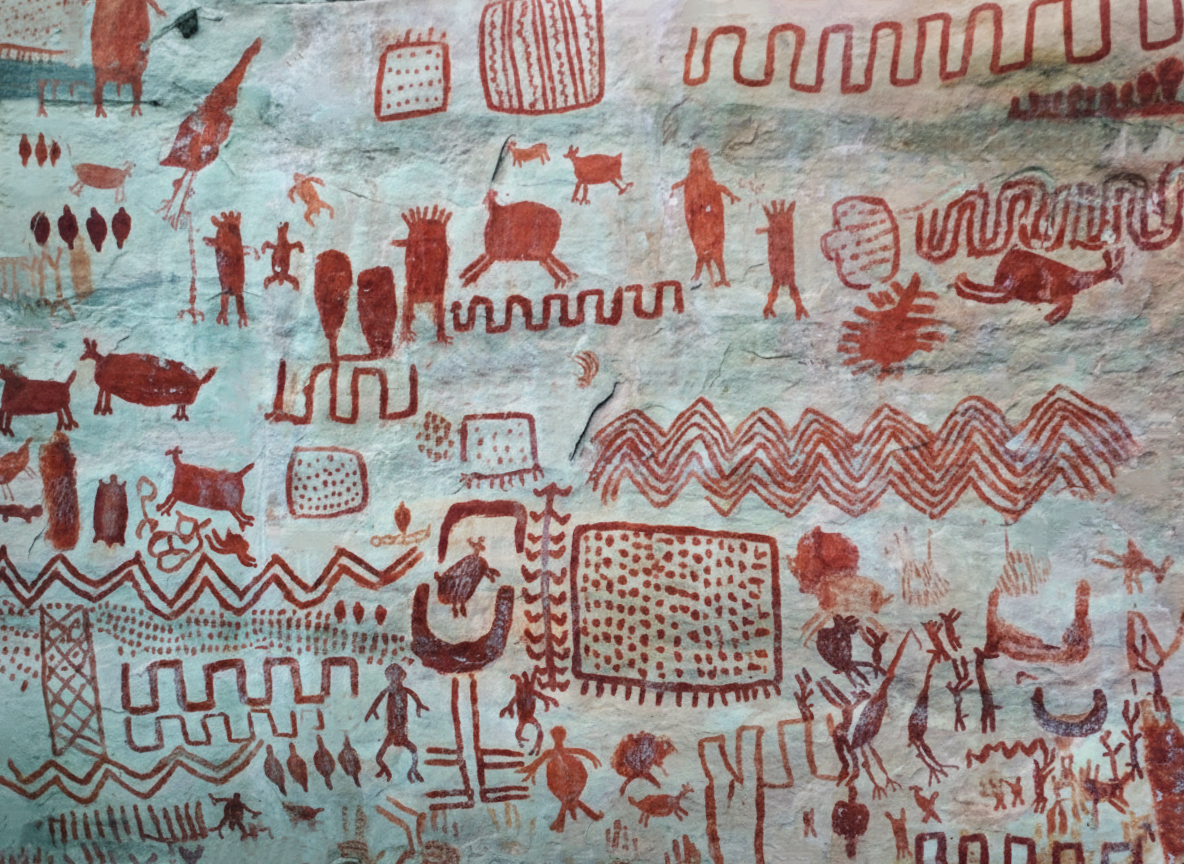
La Capilla Sixtina de la Selva Amazónica
Las paredes de arenisca de Chiribiquete albergan una impresionante colección de más de 75.000 petroglifos y pictogramas, que revelan la fascinante historia de la humanidad en la selva a lo largo de milenios.
Estas cautivadoras representaciones, cuidadosamente grabadas y pintadas en las escarpadas paredes rocosas, nos ofrecen una visión esclarecedora de las arraigadas creencias, las venerables tradiciones y las narrativas atemporales de los pueblos indígenas, para quienes la selva amazónica ha sido un hogar a lo largo de toda la historia humana.
No son solo una ventana al pasado, sino también un homenaje a la creatividad universal del espíritu humano, un impulso que siempre ha buscado expresar pensamientos y sentimientos a través de representaciones visuales.
El estudio de estas obras de arte prehistórico nos proporciona una visión única de la evolución cognitiva y cultural de las sociedades antiguas, amplía nuestra comprensión de la experiencia humana y abre nuevos horizontes para el entendimiento de nuestra historia compartida.
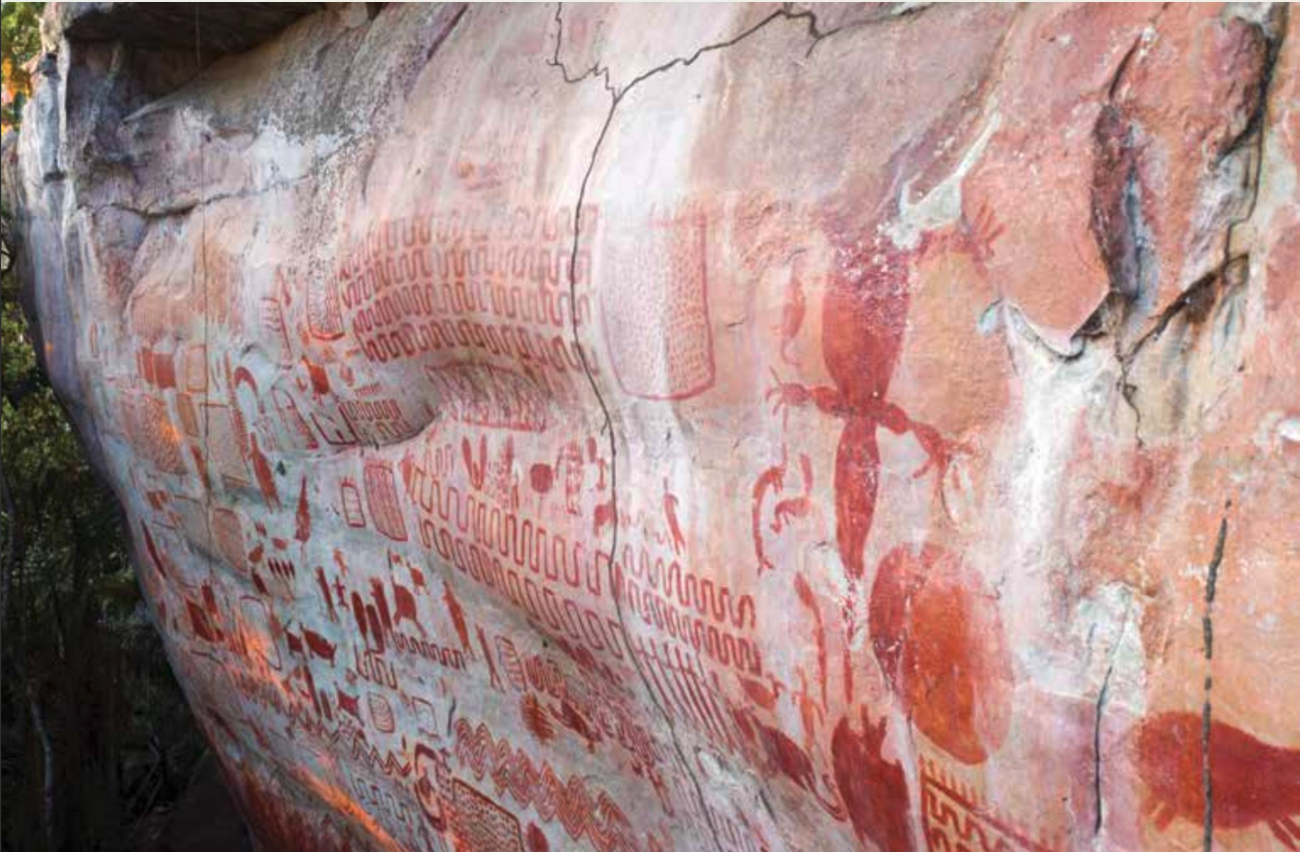
En el Reino de la Magia y las Maravillas
Los primeros habitantes del Amazonas ejercieron su arte en las paredes de arenisca de Chiribiquete, y estas pinturas son un testimonio extraordinario de su cosmovisión. Chiribiquete sigue siendo mitológicamente significativo para varias tribus y es conocido como el «Gran Hogar de los Animales» (o «Maloca Grande de los Animales»).
La diversidad de motivos, a menudo realistas, así como el uso de los sitios para ceremonias por parte de comunidades no contactadas, ponen de manifiesto que este es un lugar legendario, considerado sagrado por las tribus que allí viven, y exigen con firmeza que no sea accesible al público.

Formas de Vida Indígenas para un Futuro Sostenible
Chiribiquete se encuentra en la intersección de cuatro provincias biogeográficas: el Amazonas, los Andes, el Orinoco y la Guayana. Esta confluencia ha dado lugar a una notable diversidad de culturas indígenas, cada una con sus propias tradiciones, lenguas y conocimientos únicos sobre la selva.
El área es el hogar de varios grupos indígenas, incluidos los Karijona, los Nukak Maku y los Uitoto, quienes han vivido allí durante milenios y han adquirido un profundo entendimiento de sus ecosistemas. El conocimiento indígena demuestra cómo utilizar los recursos sin destruirlos.
Sus prácticas culturales, como la caza, la recolección y la gestión sostenible de los recursos, han contribuido significativamente a la conservación de la naturaleza virgen y la vida silvestre de la región. Estas comunidades ofrecen un ejemplo vivo de cómo se puede vivir en armonía con el medio ambiente.
Su profunda conexión con la naturaleza muestra cómo valoran y preservan los recursos, y cómo comprenden la importancia de la conservación a largo plazo. Sus conocimientos sobre plantas, agroforestería y la vida en la selva, transmitidos de generación en generación, son de un valor incalculable.

Ein lebendiges Zeugnis verborgen im Regenwald
Chiribiquete se encuentra en la intersección de cuatro provincias biogeográficas: el Amazonas, los Andes, el Orinoco y la Guayana. Esta confluencia ha dado lugar a una notable diversidad de culturas indígenas, cada una con sus propias tradiciones, lenguas y conocimientos únicos sobre la selva.
El área es el hogar de varios grupos indígenas, incluidos los Karijona, los Nukak Maku y los Uitoto, quienes han vivido allí durante milenios y han adquirido un profundo entendimiento de sus ecosistemas. El conocimiento indígena demuestra cómo utilizar los recursos sin destruirlos.
Sus prácticas culturales, como la caza, la recolección y la gestión sostenible de los recursos, han contribuido significativamente a la conservación de la naturaleza virgen y la vida silvestre de la región. Estas comunidades ofrecen un ejemplo vivo de cómo se puede vivir en armonía con el medio ambiente.
Su profunda conexión con la naturaleza muestra cómo valoran y preservan los recursos, y cómo comprenden la importancia de la conservación a largo plazo. Sus conocimientos sobre plantas, agroforestería y la vida en la selva, transmitidos de generación en generación, son de un valor incalculable.

Un Testimonio Viviente Oculto en la Selva
Durante mucho tiempo se asumió que en América no existían seres humanos hace $20.000$ años. Sin embargo, en Chile y Brasil hay hallazgos de pinturas rupestres tan antiguas como las de Chiribiquete, lo que demuestra lo contrario.
Los primeros pictogramas surgieron durante la última Edad de Hielo, razón por la cual también se representan animales que se consideran extintos desde hace milenios o de los que no se sabía que alguna vez existieron en el Amazonas. Chiribiquete oculta muchos secretos, pero debido a la magnitud del sitio, se sospecha que pudo haber sido un centro espiritual, una especie de «Jerusalén del Amazonas».
La exploración de este impresionante complejo está todavía en sus inicios; promete muchas sorpresas e invita a formular hipótesis fascinantes. Recientemente se descubrió que aún viven grupos de indígenas sin contacto con la civilización en la serranía. Se presume que son los últimos descendientes de los Karijona, que de otro modo se considerarían extintos. Se les ha observado pintando paredes de roca con imágenes.
El arte rupestre de la Serranía de La Lindosa no es solo una colección de imágenes; es un testimonio vivo del poder perdurable del arte y de la profunda influencia de la presencia humana en la Tierra.
Desde siempre, los sitios arqueológicos han ejercido una profunda fascinación en mí, y cada uno despierta un sentimiento muy especial. Aunque los haya visto en innumerables imágenes y fotografías, es una experiencia verdaderamente singular verlos con mis propios ojos y sentir su imponente presencia personalmente en el lugar.
Más información en el Instituto Colombiano de Antropología e Historia
Visita anturiongallery.com
Escrito por Rolf Friberg
Photos © Thomas Peschak
Articulos Relacionados
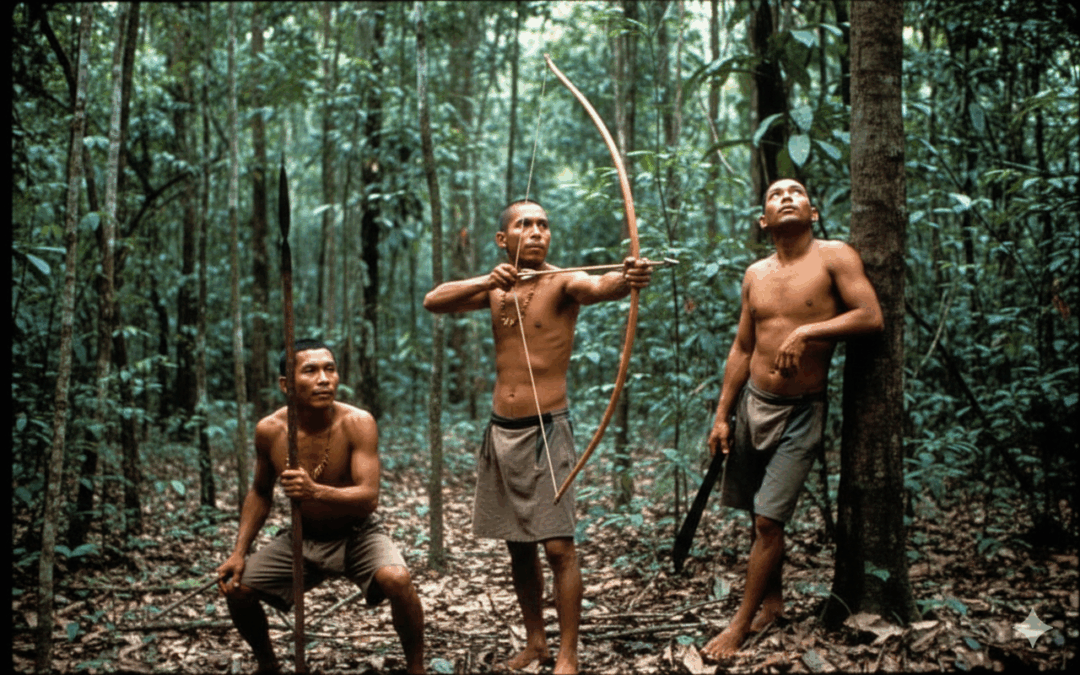
Los Nukak Makú: Expulsados del Paraíso
Testimonio de la resistencia y lucha por la supervivencia cultural de uno de los últimos pueblos nómadas que existen todavía en el Amazonas.

Los Nukak Makú: Expulsados del Paraíso
Testimonio de la resistencia y lucha por la supervivencia cultural de uno de los últimos pueblos nómadas que existen todavía en el Amazonas.

Los Nukak Makú: Expulsados del Paraíso
Testimonio de la resistencia y lucha por la supervivencia cultural de uno de los últimos pueblos nómadas que existen todavía en el Amazonas.
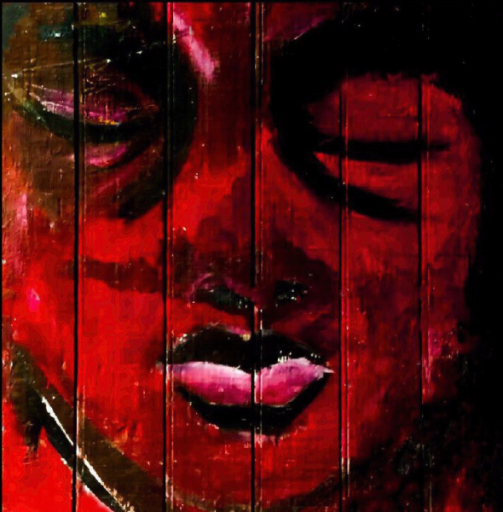

0 comentarios